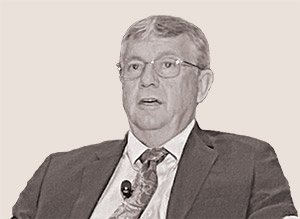Learning to build successful teams, advocate for new technologies, communicate effectively and adapt to market realities are critical skills that young construction industry professionals need to advance careers, said participants at ENR’s Top Young Professionals Conference.
Robert Penney, Skanska USA's national director of continuous improvement, shared at the event, held in Tempe, Ariz., on Feb. 24-25, his “secret sauce” for building high-performing project teams. “We know high-performing teams are possible—we’ve all been on them,” he said. “But how can we consistently replicate them?”
Rather than replicate the team itself, “we standardize the creation of the team,” Penny suggested. "High-performing project teams are built on trust, transparency and communication—the foundations for how to collaborate as a team.” The structure, he adds, “is an aligned vision of success.”
Team members have accountability and engagement and are motivated individually and collectively, he noted. Because a project team works over time, it needs a system for operational excellence that involves clarity of process and a culture of continuous improvement.
Penny also tapped a panel of speakers to discuss team success by building “harmony, not homogeny.”
Tupac de la Cruz, founder and operations manager at contractor Roofing Solutions, noted challenges of meeting benchmarks with four different generations in the workforce that all have different styles of communicating, from “email to texting to snap chat.” Nicole Brown, an associate vice president of AECOM, used a music metaphor for project team success, since an array of musicians come together to create a single musical performance.
“Everyone has their own part to play, but the job of the team is to understand the music we are playing." she said. "What’s our goal? You don’t scat during Handel’s Messiah!”
Nick Martinez, an Ironworkers Local 433 member and general field superintendent for Red Cedar Steel, said that for a large automotive building project in the Phoenix area on which he is working, maintaining a harmonious team requires tapping every option to keep staffing at required levels.
“We are bringing in workers from every location possible—everyone is from somewhere else with all kinds of attitudes,” he said, “But we have to put them together and make sure we can work safely with multiple cranes six to seven days a week and meet a schedule that has already been committed to.”
Finding A Group
Finding one’s footing when joining the workforce—regardless of industry—can be daunting. First-generation Bechtel Corp. employees Isabel Siordia and Valentin Martinez, who identify as Latinx, discussed how Business Resource Groups (BRGs) help young minority workers adjust to the AEC industry.
With the added complexity of joining the industry during the pandemic, Siordia, a construction engineer for Bechtel Equipment Operations, said that employee groups organized around commonalities such as ethnicity, gender and age accelerate diversity, inclusion and business change.
Siordia said the company BRG has increased her visibility at the firm and at conferences. Aside from improving her leadership skills and providing access to senior management, she also said it has helped her tackle a fear of “public speaking, as you can see.”
Project controls engineer Martinez said BRGs improve employee morale, mental health and performance. “Not only is it beneficial for the employee but it also benefits the company,” he said.
Martinez also said the BRG gave him the confidence to help peers who were nervous about transitioning from Microsoft Excel to Microsoft Power BI, an interactive data visualization software. “They were very appreciative when I was sitting down with them to say, ‘This is how you build a data sheet,’” he said. “That gave them the encouragement to go use this tool.”
Advocate for Tech
Even the smallest technology adoptions can have a big impact on safety and productivity, and young leaders are among those in the industry driving their adoption and use. Ankur Podder, research engineer at the US Energy Dept,'s National Renewable Energy Laboratory, and Michael Giacco, director of technology at AI Engineers Inc., presented real-world findings about adopting cutting edge technology at jobsites—including drones, additive manufacturing, 4D planning software and digital twins.
These all serve a role in addressing big picture problems such as climate change resilience and reducing carbon emissions. But firms must avoid “innovation for innovation’s sake,” said Giacco.
Podder said his lab helps industry “understand what’s next in a pragmatic way” by collaborating to “understand where they are at now, what they need and how they can push forward.”
Going beyond simply deploying drones to inspect multi-story buildings for retrofits, his team has tested material-spraying drones to avoid erecting scaffolding that can lead to accidents. “That’s the ‘what’s next,’” Podder said. “We work with entities in the space to see if there’s funding or demonstrations where we can work together and prove this out.”
Podder also tries to poke holes in conventional industry wisdom, such as that offsite fabrication and modular construction are widely considered to be more productive because of controlled environments. “That’s where we come in to really understand if their final projects are better quality," he said. "You are delivering faster but are they more energy efficient at the end of the day?”
Giacco encouraged young professionals to convince their firms to adopt more technology.
“You need to spend a lot of time crafting your rhyme behind the reason for bringing technology to management and why this will be useful. Practicality is a big thing,” he said. “You can’t do tech for tech’s sake. Get your pitch straight, your elevator speech correct and focus on ground work. Take baby steps.”
One conference participant, acknowledging that drones are easily justified for inspecting large-scale bridges with difficult access areas, asked how they can be justified to inspect smaller bridges such as single span structures.
Giacco pointed out that using a drone avoids using equipment such as snoopers or having to arrange a police detail and closing a lane of traffic. “You can fly the drone underneath the bridge to inspect it without any of those added efforts that are less safe,” he said, adding that people tend to “let their guard down” during routine inspections. “Now what is mundane suddenly becomes dangerous,” he said. “This technology will help you mitigate that situation.”
Giacco said that use of aerial mounted ground penetrating radar on a drone to inspect underground utilities is five to six years away as a “pinpointed beam to look beyond the curtain.” He said he recently saw this technology firsthand, which was the “first indication that we will have something unique that will allow us to do something we haven’t done in the industry before.”
Infrastructure Act Unknowns
Young professionals also gained a sense of the challenges in rolling out new project funding from the Infrastructure Investment and Jobs Act, the $1.2-trillion law enacted last year.
Funds are flowing to states in a “very piecemeal fashion” with “fairly slow” guidance from the U.S. Dept. of Transportation and the Federal Highway Administration, said Gregory D. Byres, deputy director for transportation and state engineer at the Arizona Dept. of Transportation.

Gregory D. Byres, Deputy Director, Arizona Dept. of Transportation
States are running under a continuous resolution rather than a defined budget, Byres explained. Stakeholders don’t know how much and when the funding will reach states.
“Most things we just don't know. We're hoping there will be in the next couple weeks, another continuing resolution, [then] we'll start to see a little bit more on the funding side,” he said. “Once that funding does start to kick in, we'll start seeing a little bit more of the rule making.”
Timing is one major issue facing state DOTs. Half of the fiscal year is already gone, but the new funding must be spent within the fiscal year—and those funds are not yet on hand.
“One of the things that’s starting to scare me more than anything else is if we get these dollars very, very late in the year,” Byres said, is whether the industry will have capacity “to be able to fulfill the projects that we’re going to put out.” The state DOT will focus on trying to distribute work statewide as much as possible. “If we saturate the market to the point that we’re driving costs up, then it’s not worth it for all of us," he said.
The law is broken into two separate categories: formula funding, which is guaranteed funding to each of the states based on population and other factors, and discretionary funding, which will be the larger part of the package.
“The formula funding is guaranteed dollars to the state," Byres said. "For the state of Arizona, we're looking at an additional $200 million in FY 22.” .
Arizona must also contend with its booming economy and with state dollars at historical levels, which adds to the complexity of figuring out how to roll out so much work with finite resources.
Byres noted more state dollars than "what we're getting at the federal level." He said that “with the state dollars flowing in, that gives us a bonding capacity to actually even double or triple what we can possibly do. It also gives us the ability to delay projects and ... a little bit more room on how we can deliver those projects.”
Arizona DOT's five year program for FY22-FY27 is the largest in agency history. In FY26 and FY27 alone, there is more than $800 million just for transportation, Byres explained.
He added that the funding has sub-allocations for major municipalities, planning organizations, non-profit groups and councils of government across state.
“We don't know how much we're going to have to give up to those NPOs and municipalities,” Byres said. “Best guess that we have is about 30% to 50% of the funds coming into the state will get sub-allocated.”
His agency will focus on trying to distribute work statewide as much as possible. “If we saturate the market to the point that we're driving costs up, then it's not worth it for all of us,” Byres said.
More Challenges Ahead
Infrastructure work will also compete with the private sector, he added, pointing to the planned $12-billion Taiwan Semiconductor factory under way in Chandler, Ariz.
"It's so large that it is becoming difficult to find iron workers because they they're getting sucked up in that one project,” Byres explained. “The first time I saw it, I thought somebody had opened up a new crane supply or rental company, because there were probably 40 or 50 cranes on that site. When you have that going on within the state, that's something else that we're competing against as well.”
Many conference attendees shared that their firms are already preparing for an influx in public infrastructure work.
With Congress developing a new national renewable energy standard that requires utilities to generate a specific portion of power from renewable sources, the time is ripe for engineers to innovate in the carbon-cutting economy, said Nooshin Behroyan, CEO of the California-based professional services firm, Paxon Energy and Infrastructure Services.
“As engineers, it is crucial that we come up with innovative approaches, because we are collectively moving the industry forward.” she said.
But when it comes to building for climate change resilience, Behroyan stressed that the construction industry isn’t moving fast enough and engineers have a responsibility to help push clients in a sustainable direction.
“Climate change is not linear, it’s exponential; meaning that the worse it gets, the faster it goes,” she explained. Therefore, there is a booming opportunity in the carbon-cutting economy for engineers who can create “net positive solutions” within their scope of work, she said.









Post a comment to this article
Report Abusive Comment